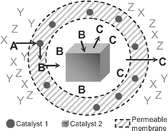Palladium nanoclusters in microcapsule membranes: From synthetic shells to synthetic cells
Abstract
We show that polyelectrolyte shells may be perfect hosts and microreactors for catalysis. Using a layer-by-layer self-assembly process to form hollow polyelectrolyte capsules, we show that individual layers can be replaced by palladium and gold nanoclusters forming robust cell-type microcapsules. Testing the catalytic activity of those embedded nanoclusters using the Sonogashira cross-coupling reaction, we show that simple self-assembled polyelectrolyte shells are ideal as carrier of at least one expensive


 Please wait while we load your content...
Please wait while we load your content...